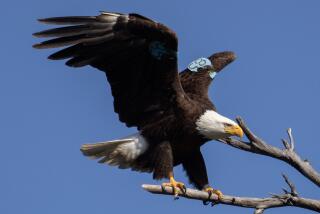Condor Egg Hatches in Wild as Scientists Watch
- Share via
For the first time in 18 years, a pair of California condors have laid, brooded and hatched an egg in the wild, thrilling biologists and wildlife officials who hope similar births will someday lift North America’s largest bird off the endangered species list.
Chubby, bald-headed and covered in fluffy white down, the tennis-ball-sized chick hatched last week in a high sandstone cave deep in the Los Padres National Forest north of Fillmore in Ventura County.
Biologists, who have monitored the egg for almost two months, say the condor parents are being gentle and feeding the chick every day. That’s significant because condor pairs have been known to tear their chicks apart in parental spats over who gets to feed the baby.
“We are ecstatic,” said Bruce Palmer, California Condor Recovery program coordinator for the U.S. Fish and Wildlife Service. “We are jumping up and down over this whole event. In so many ways it has validated the work we have done over the years. So far, the pair seems to be doing the right things.”
But there is fear that inexperienced parents or predators such as golden eagles and ravens will kill the young bird.
Chicks are especially vulnerable in the first few weeks, and it will take six months before the baby will be fully feathered and ready to fly.
With that in mind, wildlife officials are tempering their excitement with caution.
“I will keep my fingers crossed until it takes its first flight,” said Michael Barth, a biologist at the Hopper Mountain National Wildlife Refuge near Fillmore, which supervises condor recovery efforts in Southern California. “[But] a lot of people doubted whether the birds could get to this point, and here they are.”
Allan Mee, a biologist with the San Diego Zoo, witnessed the hatching.
Last Wednesday, while observing the egg with binoculars from an observation post, he saw a sizable hole appear on one side. A crack appeared shortly after. The male was sitting on the egg at the time. Then the female returned and began turning the egg over and over.
“The female stood on the shell gently and the chick rolled out,” Mee said. “She homed in on the chick and they started to brood it. It was like a new toy for them. The male was very keen to play with the chick.
“They were both very gentle; there was no aggression there. I was pretty amazed and relieved that it hatched.”
In 1982, scientists began gathering condor eggs from the wild. The last egg hatched in the wild was in 1984, and the $35-million condor captive breeding program began the following year.
Facing extinction, condors were taken in from the wild, bred in captivity and, starting in 1992, released again, along with their young. Since then, scientists have been waiting for the younger birds to become sexually mature and begin laying eggs.
Hopes were raised last year when a condor egg was found in rural Santa Barbara County. Hoping to protect the egg, scientists removed it and substituted a fake ceramic egg in its place. The real egg was put back when it was near hatching. But three days after it emerged, the chick was killed by a female condor for reasons that remain unclear.
The condor population is slowly recovering, however. There are 63 condors living in the wild in California and Arizona, 18 in field pens awaiting release and 104 in captivity.
Most of the wild birds, which have 9-foot wingspans and weigh about 20 pounds, live in sanctuaries in Big Sur, Los Padres National Forest and the Grand Canyon. The recovery program wants to develop a population of condors in California and Arizona with 150 birds each, including 15 breeding pairs, Palmer said.
“My job is to get them off the endangered species list,” he said. “And our first goal is to get them down-listed from endangered to threatened.”
Mee has been studying the egg since mid-February. Over the next two weeks, he said, the chick could die of exposure unless warmed constantly by the parents.
“It is still very dependent on its parents,” he said. “But they seem to know what to do when it comes to feeding and brooding.”
Earlier efforts by Fish and Wildlife Service scientists to remove the egg and replace it with a phony one failed when the male aggressively defended his nest. His strong parental instincts buoyed the confidence of the biologists.
California Condor Recovery Team leader Mike Wallace shot video of the chick and its parents.
“What I saw was very encouraging,” he said. “They nibble the chick around the face and preen it. They are gentle and cautious.
“But I got a report on Saturday that the calmness was frayed and they were getting agitated with each other.”
Wallace said the entire effort is fraught with unknowns. “We are guardedly optimistic,” he said. “It’s a new situation for them and they don’t know how to relate yet.”
More to Read
Sign up for Essential California
The most important California stories and recommendations in your inbox every morning.
You may occasionally receive promotional content from the Los Angeles Times.










